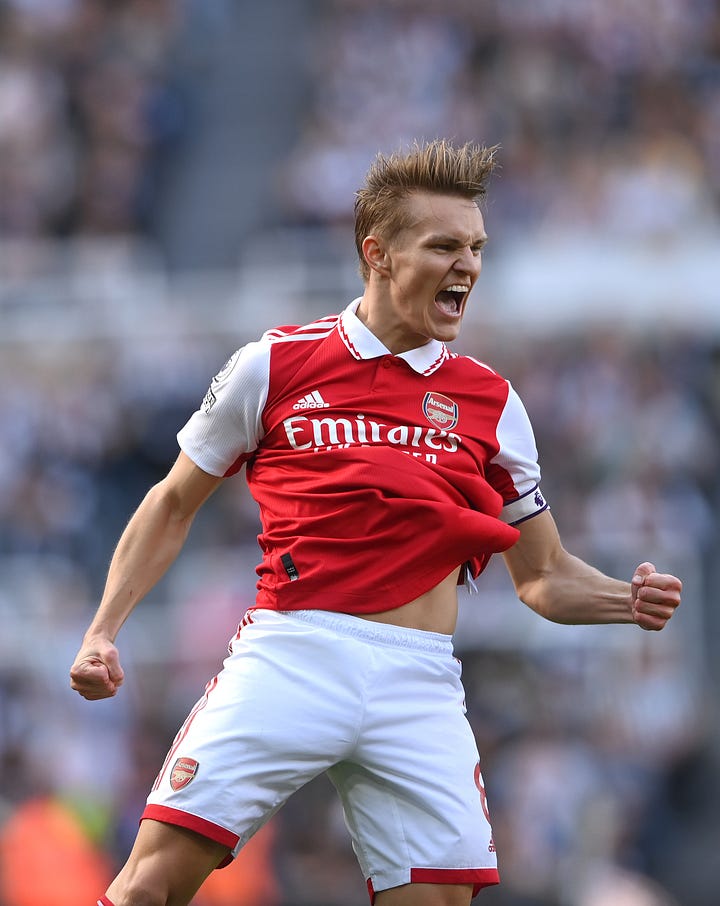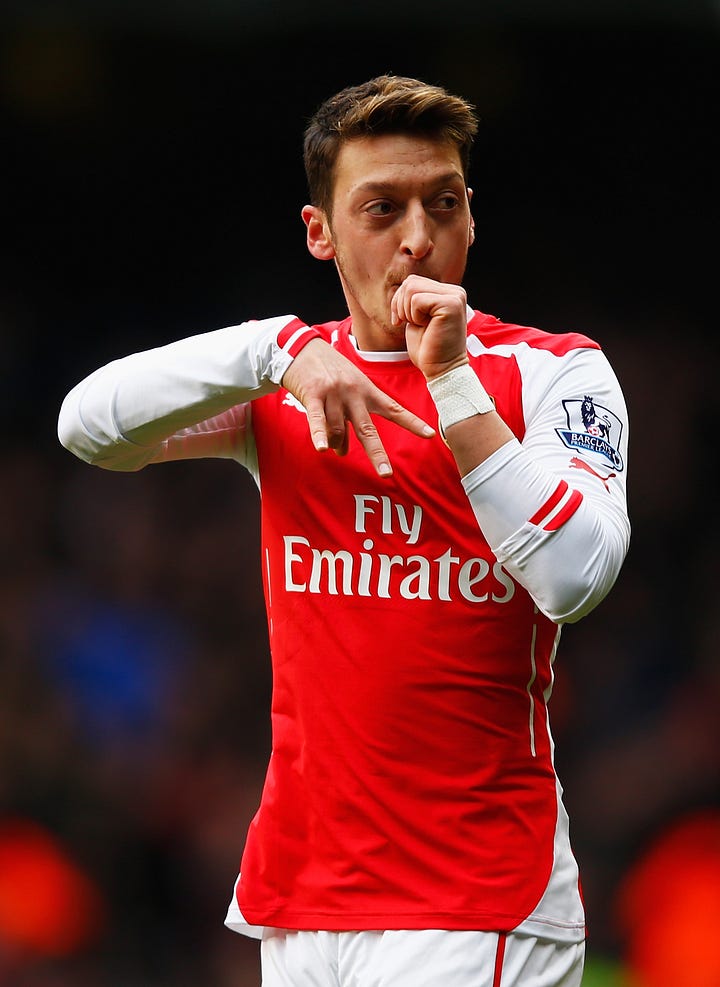Martin Ødegaard Strives for Greatness
Arsenal's captain and conductor faces the ultimate test against Man City this weekend.
THE MIDWEEK is a Wednesday newsletter tackling a big idea, a big piece of news, or a big interview. For full access, you can:
︎⚽️Become a member of THE FOOTBALL WEEKEND
🎟️Get a free month of membership when you refer two friends as (free or paid) subscribers
“It’s come for Ødegaard, who’s had a quiet 10 or 15 minutes after a bright start,” Clive Tyldesley announced as the conductor of Arsenal’s orchestra latched onto a loose ball at the edge of the attacking third. His team trailed 1-0 on aggregate with about 55 minutes to go in the Champions League Round of 16, struggling to break down a wily Porto side with solid structure and a studied command of the dark arts.
Then Martin Ødegaard corralled the ball high up the pitch—typically—and shook off a retreating midfielder with a feint that took him towards the outside. He found Leandro Trossard wide, then took a couple steps towards the 18-yard box. Except he didn’t go—he held his ground—and the ball came back to him. Then the magic began.
Francisco Conceição came steaming in from the flank to press him as he received the ball, but the Norwegian let it run across him to his right foot, shielding it from the pressure. As Porto’s #10 came around his hip to get at it, he’d already shifted it back onto his left foot. The sheer dexterity of it sent Conceição flying away, and suddenly Ødegaard was in a couple yards of space outside the box.
He took two more quick touches with his left boot, four defenders in the vicinity now but not nearly close enough, none of them prepared for what was about to happen to them. As all eight eyes fixed themselves to Arsenal’s #8, desperately reading for what he might do next, Trossard scampered in behind. In a flash, Ødegaard split them open with one slide-rule pass, taking all four out of the game, falling delicately to the pitch as he did it, watching from his hands and knees as his teammate dispatched the ball into the bottom corner to bring the tie level. He’d unlocked the match with a single extended flourish of skill and invention.
The comparisons to another playmaking legend of the modern era are obvious. The sublime left-foot and the pronounced left-footedness; the X-ray vision and the innate understanding of the geometry of the game; the red and white kit of the Arsenal. In his pomp, Mesut Özil was a genius technician and a combination-play savant, the product (famously) of the cages of Gelsenkirchen. But he never scored enough goals and—nothing new here—he simply did not work hard enough off the ball. The German ran plenty of yards each match, but the modern game is about pressing intensity, repeated sprints, the constant hunger to win the ball high up the pitch. It’s about the leader of the press firing up the machine with body language that communicates absolute commitment to the manager’s scheme.


In all these things, Ødegaard is what Özil was not. It’s no coincidence that he was in position and alert to win the second ball with Porto’s midfield layer ahead of the play and out of position—the kind of split-second, highly marginal advantage that decides games at the top level. He leads the Arsenal press and forms the central cog of the machine when they’re in possession, every bit Mikel Arteta’s on-field general. He is captain of Arsenal and of Norway, a consummate professional and relentless competitor. The beauty of his game, the elegance and the spark, sit atop this sturdy foundation. It’s a microcosm of this Arsenal side and how far the club has come since Özil was doing his thing.
This Sunday, Ødegaard has the chance to test himself against the very best there is. If he represents an evolution from Özil’s feline facilitator to a more ruthless beast, Kevin De Bruyne is the apex predator. There’s the 65 goals and 110 assists in 251 Premier League appearances, sure, but the Belgian maestro is far more than that. He’s also a front-presser and a competitor in the trenches like Ødegaard, a two-way player, but he has tools in his kit that the Arsenal man does not. There’s the outrageous range of passing, including his ability to put a crossing shape on the ball from close to the halfway line. There’s his power when running with the rock, as the defenders who manage to keep pace often just bounce off of him as he dribbles on and on and on. There’s the deadly delivery from set pieces, the capacity to strike the ball clean and true at goal from any distance. He’s more humanoid than human at times, and he lacks Ødegaard’s delicate artistry, but he is mercilessly effective.


